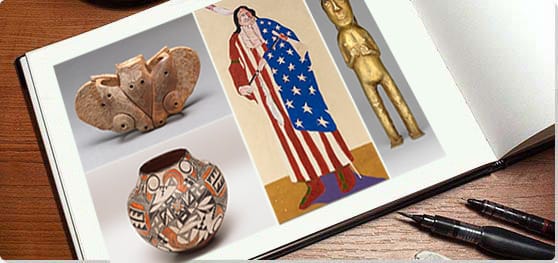Summary of Indigenous Art of the Americas
The art of Indigenous North, Central, and South American cultures spans millennia and continents, from the walrus tusk carvings of the Arctic-based Dorset culture to the elaborate fiber art of the South American Incas. Some of these cultures have been extinct for hundreds or thousands of years. Others survive today with contemporary artists working in response to ancient creative customs. Any attempt to define Indigenous American art in the round risks reducing it to Eurocentric stereotypes. However, a number of consistent features can be picked out concerning its spiritual and social functions, and its common media and motifs, allowing us to appreciate the beauty and splendor of these living traditions.
Key Ideas & Accomplishments
- The example of Indigenous American art partly shows the great damage done by European imperial expansion from the Renaissance onwards. Colonization of the American hemisphere generally involved subduing or eradicating native cultural traditions. At the same time, Indigenous American art developed in response to the new markets and influences that white settlement provided.
- Indigenous American art was often used to venerate or record the achievements of leaders - as in the Maya tradition of courtly sculpture - or to honor the gods. In some Indigenous art, such as the giant stone heads of the Olmec culture, the figure of ruler and divine being seems to merge. Indigenous American Art thus often carries a special sense of spiritual power.
- Art often had a practical role in ancient American societies, as in the creation of textiles and pottery. However, there was no distinction between craft and fine art in these civilizations of the kind that holds in the contemporary West. Craft objects might well have been amongst the most prized artistic objects of the communities they served as well as having a role to play in everyday life.
- Often, Indigenous American art will represent a sense of the universe that we might now call pantheistic, sensing the divine in the natural world and locating it in particular in certain places, objects, and living things. Much Indigenous art shows a related sense of overlaps and relations between human and animal life. This predicted many aspects of Romanticism and modernism in Western art, meaning Indigenous American art has had a profound global impact.
- Indigenous American art is not a dead tradition but one that spans back through history while yielding many living strands. Across the twentieth century and beyond, artists such as Bill Reid and Fritz Scholder combined themes and motifs from their cultural ancestry with aspects of modern art aesthetics such as abstraction and Pop Art, creating unique and important bodies of work.
- The contemporary Western idea of art for art's sake is mostly unhelpful in trying to make sense of Indigenous American art. Art was far more likely to serve a practical or spiritual function than to be appreciated solely for its aesthetic qualities, although beauty and complexity of design are everywhere evident. This makes it very unique when considered in relation to modern and historical European art.
Overview of Indigenous Art of the Americas
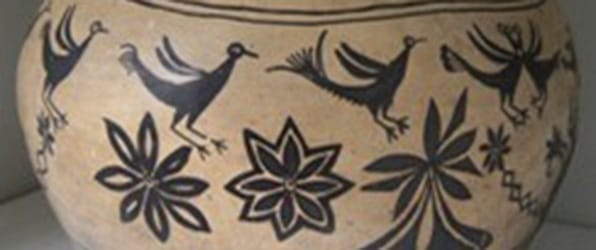
The art created by Indigenous peoples of North, Central, and South America is as rich and varied as the landscapes of the three continents. American Indigenous artists were some of the earliest to create art in the history of the world, including pottery, cave paintings, carvings, and fiber designs that date back to prehistoric times. Often featuring figural and animal imagery, these works often attempted to make sense of the world, record visions or document important historical events. While some of the civilizations that created this work are no longer in existence, others have artists still creating works today. All of them have cultural histories rich in religious ritual and iconography and respect for the land. Describing the artistic contribution of Native American cultures, author David Penney states: "whether personal or cultural expression, or both, whether in the past or in the future, Native artists vitalize their thought and our perception through their ability to create powerful objects and images."
Artworks and Artists of Indigenous Art of the Americas
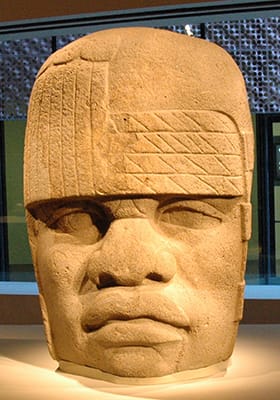
San Lorenzo Colossal Head 4
This massive stone sculpture is one of 17 known works of Olmec origin depicting stylized male heads. It is also one of ten found in the ruins of the former Olmec city of San Lorenzo, in present-day Mexico. These pieces all bear marked similarities but each is also unique, as Ayodale Braimah explains: "all of the sculptures depict a helmeted man but each individual sculpture has its own set of unique facial characteristics." Each helmet is also unique in appearance. Braimah adds that the heads, which are estimated to weigh about 40 tons and stand between 10-15 feet tall, bear traces of pigments and plaster, "suggesting that the heads may have been painted at one point."
The colossal heads of San Lorenzo are amongst the most mysterious and breathtaking works of early American Indigenous art. Their value and function is not certain but, according to Mark Cartwright, "the most agreed upon theory is that, because of their unique physical features and the difficulty and cost involved in their creation, they represent Olmec rulers." Why the representations were forged on such a large scale is also debated, but one likely answer might explain core aspects of Olmec belief. As Mary Ellen Miller describes, "Mesoamerican peoples believed that all experience and emotion, along with the soul, resided in the head alone." The size of the works might attest to this fact, as well as to the wisdom of the Olmec rulers.
Miller also points out, however, that aspects of the works' sculptural forms may nuance the idea of simple veneration. "[T]he ten colossal heads...are of greatly varying size...and the defacement, cuts, and other markings on the heads themselves may also alert us to the transience of mortal power."
Basalt Stone - Museo de Antropología de Xalapa, Veracruz, Mexico
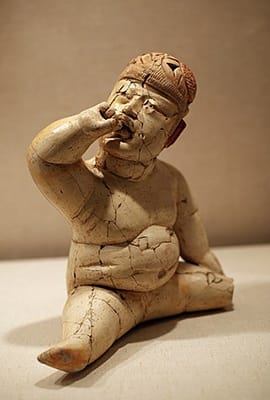
Seated Figure
This small figurine features a chubby baby with legs spread apart, staring off over its right shoulder. The affectionate, naturalistic representation of thumb-sucking confirms the likely young age of the subject. However, the gender of the child is not clearly defined.
The now extinct Olmec civilization of ancient Mesoamerica is renowned for the beauty of its figural sculptures, several of which represent children. According to the Metropolitan Museum of Art website, "this pudgy figure is one of the best examples of this class of human figures displaying characteristics of well-fed children, the so-called Olmec 'babies.' The body of the baby was careful[ully] modeled to indicate realistic folds of skin and subcutaneous fat, evoking themes of abundance and plentiful resources."
At the same time, the face displays what the Met calls "non-mortal characteristics," such as the stylized eyes, downturned mouth, and squared ears. "The left portion of the figure's back contains iconographic elements, such as crossed bands and crosshatching, possibly representing tattooing or scarification." These details suggest something other than a piece of naturalistic, anthropomorphic art in the modern Western style. It is more likely that the baby figure was intended to have some kind of talismanic power. Indeed, the elaborate headpiece, colored red-pink with powdered cinnabar and red ochre, reflects its use to anoint a tomb.
Ceramic with pigment - Metropolitan Museum of Art, New York, New York
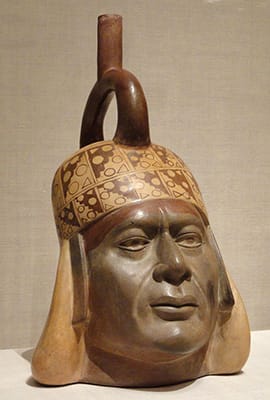
Portrait Vessel of a Ruler
One of the greatest examples of stirrup-spouted pottery, this work features as its base the head of a man. His serious expression is enhanced by the intricately detailed headdress he wears, making it clear he is an individual of power and authority within his society. The ancient Indigenous South America civilization, the Moche, were skilled potters, with the greatest examples of their work including portrait vessels like this one.
According to the Art Institute of Chicago website, bottles like these "were molded without the aid of a potter's wheel and painted in earth tones." Moche potters "represented everything about their world .. This portrait vessel portrays individual characteristics - the furrowed brow and full, slightly protruding upper lip - as well as general features recognizable among Peruvian Indians today. With this commanding expression and proud bearing, the depicted ruler conveys an indelible sense of the power of Moche leaders. His elite status is further indicated by his fine headdress, decorated with the geometric motifs of Moche textiles, and by his elongated ear ornaments and the traces of facial paint on his forehead and cheeks."
While stirrup-spouted pottery was common amongst early South American Indigenous artists and the practice can be traced all the way back to the Chavín civilization, the Moche put their unique spin on this art-form by including specific portrait depictions. Art historian Rebecca Stone notes that, "though neither the earliest nor the most widespread form, the portrait vessel is particular to the Moche and thus stands out in Andean art as a whole."
Ceramic and pigment - Art Institute of Chicago, Chicago, Illinois
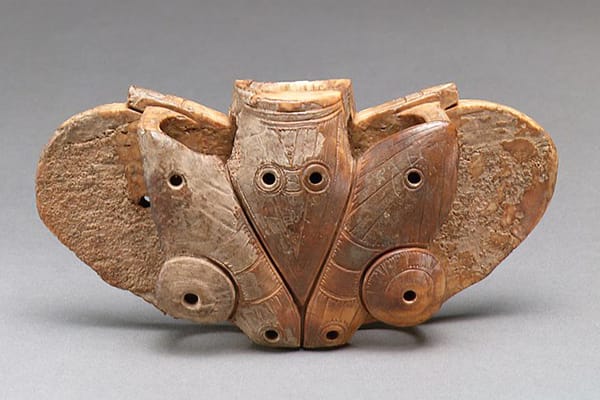
Winged Object
This elaborately detailed, carved piece of ivory, known as a counterweight, is a structural element used to construct harpoons. Created by artists of the Bering Strait of Alaska, this piece bears some resemblance to three different animal forms, although it is unclear exactly what they are intended to be. What is evident are the carefully carved lines and patterns on this piece of walrus tusk ivory.
Hunting was an important way of life for the early Indigenous peoples of the Bering Strait. Rather than simply fashioning harpoons for functional use, they included artistic details to embellish the tool. Attached to the end or base of the harpoon, this object that looks as if it has wings was used to help balance the instrument. The spiritual world was linked to, and believed to guide, the daily life of early Artic Indigenous peoples, and so they turned to artistic creative to help foster interactions with the spirit world during the course of common activities such as hunting.
According to the Metropolitan Museum of Art's website, hunting weapons would often include depictions of "animal spirits - used to attract game to the hunter - and spirit helpers that added strength to the weapon itself," By the first half of the first millennium CE, the incised patterns on tools like these had become both elegant and complex, often including arcane and hard-to-decipher elements, as seen in this work.
Ivory - Metropolitan Museum of Art, New York, New York
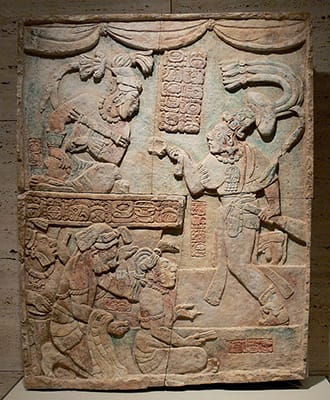
Presentation of Captives to a Maya Ruler
This large carved relief panel is an impressive work of Maya art. As described on the Kimball Art Museum's website, "it depicts the presentation of captives in a palace throne room, indicated by swag curtains at the top of the panel. The five figures are the Yaxchilan king, seated at top left, his sahal (a military chief) on the right, and three bound captives in the lower left. The glyphic text, which gives a date of 23 August 783, records the capture of a lord and a sacrificial bloodletting three days later under the auspices of the king. The three prisoners may be scribes; the one in front holds a 'stick-bundle' associated with Maya scribes, and all three wear headdresses with hun (book) knots. All figures but the leftmost captive are identified by name. The inscription on the throne front, of special interest, is carved with the king's name and titles."
This work comes from one of the greatest of the ancient Maya cities, Yaxhilan, located in present-day Mexico. Cities like Yaxhilan were were home to many great architectural structures, the interiors of which would often bear elaborate stone reliefs. These carvings were not merely aesthetically pleasing decorations or wall adornments. They were visual records of important events in the life of the community and of key Maya figures. This relief provides an important example of arguably the most popular theme in Maya art, that of royalty and courtly life. Maya rulers often turned to art as a vehicle to assert their power, document their great deeds, and protect their subjects by honoring their gods.
The function of the visual narrative here is to celebrate the victory of a monarch and his army in battle, the date indicating that it represents a specific event. Unusually, this work is signed by the artist, a gesture which the Kimball Museum notes is rare. This suggests that the piece was "considered of great value in its time."
Limestone with traces of paint - Kimball Art Museum, Fort Worth, Texas
Female Figurine
Measuring less than three inches high, this delicate gold figurine depicts a woman with hands placed in front of her, resting on her chest while she stares straight ahead. Her expression is serious and portentous, while her proportions are stylized rather than lifelike, with the head significantly larger than the rest of the body. Metalworking was one of the many mediums in which Inca artists excelled, with small gold and silver figurines being among their most impressive creations.
A piece of religious importance according to the Metropolitan Museum of Art's website, "this female figurine is made of hammered metal sheet and is analogous to other Inca miniature figurines often ritually deposited and considered sacred entities, or huacas." The piece was probably used in religious ceremonies, and created in the hinterland of the Inca empire to mark its expansion and press provincial populations into the service of the monarchy. The Met website notes that the creation of the work also demonstrates "reverence to certain sacred points in the natural landscape, including apus, or mountain deities, through the deposition of offerings."
This work partly offers visible proof of the importance of art in the service of religion and power structures within Inca culture. But it offers a second message, too, a more tantalizing one. The quality of craftsmanship evident from pieces like this leads us to consider what might be permanently lost concerning Inca artistic talent and output as a result of European colonization. According to art historian Rebecca Stone, "these charmingly mimetic, diminutive metal sculptures demonstrate a side of the Inca aesthetic distinct from the iconographic stonework and help us envision the lost grander sculptures and reconstruct the interfaces between rituals and material culture."
Gold - Collection of Metropolitan Museum of Art, New York
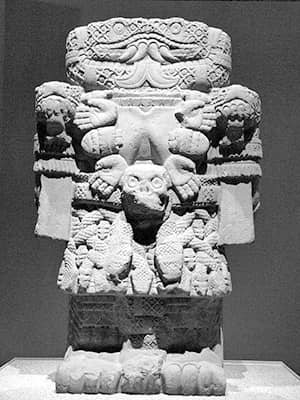
Coatlicue
This massive, freestanding sculpture, measuring almost nine feet, features the Aztec goddess Coatlicue. It is both mesmerising and terrifying. According to Mark Cartwright, the goddess is shown "in her most terrible form with a severed head replaced by two coral snakes, representing flowing blood. She wears a necklace of severed human hands and hearts with a large skull pendant. She also wears her typical skirt of entwined snakes whilst her hands and feet have the large claws which she uses to rip up human corpses before she eats them....At her back her hair hangs down in 13 tresses symbolic of the 13 months and 13 heavens of Aztec religion." While it is now an important museum treasure, this sculpture was so upsetting to colonial archaeologists that when it was discovered in 1790 it was reburied, only to be unearthed again some time later.
One of the most famous of all Aztec sculptures, this fearsome likeness of Coatlicue indicates the importance of gods and religion in the civilization's daily life. Coatlicue, whose name translates to "Serpent Skirt" was, according to Cartwright, "a major deity...regarded as the earth-mother goddess. Represented as an old woman, she symbolized the antiquity of earth worship....Coatlicue was also the patron of childbirth, was associated with warfare, governance and agriculture, and considered the female aspect of the primordial god Ometeotl."
This statue also includes a feature not intended to be seen by human eyes, again emphasizing the spiritual function of Aztec art. Like many such sculptures, this piece includes a depiction of an earth monster on its underside. This element was made for the attention and exaltation of supernatural beings, not for the mortals above ground.
Basalt - National Museum of Anthropology, Mexico City, Mexico
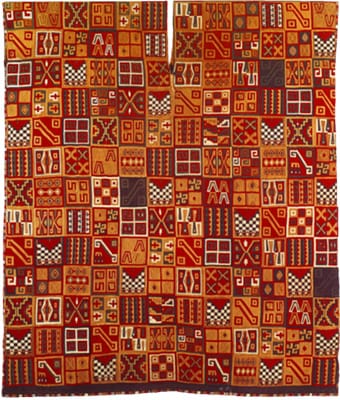
Tupa
Inca artists are perhaps best known for their elaborately detailed fabric and textile designs. This tunic, designed for use by royalty, is amongst the grandest examples of this style of artmaking surviving today, partly because of its amazingly detailed squares of woven symbolic designs.
According to art historian Rebecca Stone, "among its many motifs the royal tunic includes images of other Inca tunics: notice the tiny black-and-white checkerboard with red stepped yoke motif that is the Inca army uniform in miniature, accurate down to a minute neck slit line. This expressly proclaims the ruler as the commander-in-chief. The army motif is interspersed among other square geometric designs, all known as tocapus, that were reserved for nobility and usually comprised only small waistbands. The variety found in the royal expanse of tocapus broadcasts the message that the ruler controls more diversity, more ethnicity, almost the totality of possible patterns in his clothing."
The symbolic connotations of this piece reflect the use of Inca art to establish status and convey social and political messages. According to Mark Cartwright, even the colors used in artworks like these have "specific associations. For example, red was equated with conquest, rulership, and blood...Green represented rainforests, the peoples who inhabited them, ancestors, rain and its consequent agricultural growth, coca, and tobacco. Black signified creation and death, while yellow could signal maize or gold."
Woven fiber - Dumbarton Oaks Library and Collection
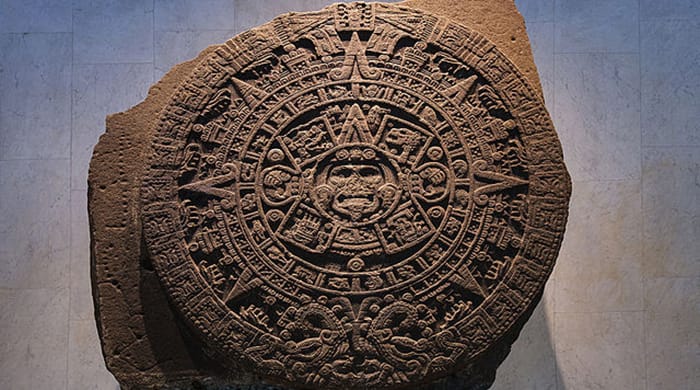
Calendar Stone
Sometimes referred to as the "sun stone," this work, measuring 12 feet in diameter and weighing an impressive 24 tons, consists of a massive stone disc featuring depictions of the five suns associated with the duration of Aztec civilization. According to Mark Cartwright, "at the centre of the stone is a representation of either the sun god Tonatiuh (the Day Sun) or Yohualtonatiuh (the Night Sun) or the primordial earth monster Tlaltecuhtli, in the latter case representing the final destruction of the world when the fifth sun fell to earth. The tongue is perhaps also a sacrificial knife and, sticking out, it suggests a thirst for blood and sacrifice. Around the central face at four points are the other four suns which successively replaced each other."
While this work is described as a calendar, it has very little to do with recording the passage of time in a simple, material sense. Instead, it provides an excellent example of how the Aztecs used art to record their creation story and to predict how their world would end. It also indicates the ways in which objects now too easily viewed as ethnological curiosities had vital social and cultural functions at one time. As Mary Ellen Miller observes, "the Calendar Stone is exhibited and reproduced as a wall panel today, but it was probably set on the ground, with blood offerings anointed on the earth monster. When recovered in the eighteenth century, the stone had been placed face down, to keep further apocalypse at bay." Referring to the Spanish colonization of the continent, Miller notes that, "[a]lthough the Aztec world did not end in earthquakes, as predicted, it ended in cultural cataclysm, perhaps a metaphorical earthquake."
Basalt - National Museum of Anthropology, Mexico City, Mexico
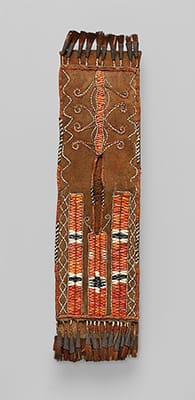
Belt Pouch
This elaborately detailed belt pouch is believed to have been made by either a Haudenosaunee or an Iroquois artist. According to the Metropolitan Museum of Art website, "bags of this type were made by women for men to fold over their belts; a slit in the center serves as the opening. The shiny dyed porcupine quills provide a dramatic contrast to the softly textured dark brown leather, and a fringe of metal cones and red-dyed deer hair adds another dimension of texture and color. The bold palette of vivid red, black, and white is characteristic of northeastern Woodlands quillwork of the period."
Bag-making has a long history in the artistic cultures of Indigenous North America, particularly in the east of the continent. This work is an example of one of the early bags that were more traditional in nature and had been produced for centuries at the time of European colonization. Later, according to Janet Berlo and Ruth Phillips, the bags changed in style as a result of contact with European culture. Artists began, "weaving decorative bands of glass beads instead of quills, replacing hide with fabric, and dyed deer hair with wool yarn." Importantly, this work shows that while European settlers may have influenced Native artists' work, even their more contemporary creations are still anchored firmly in their roots.
Tanned leather, porcupine quills, dye, metal cones, and deer hair - Metropolitan Museum of Art, New York, New York
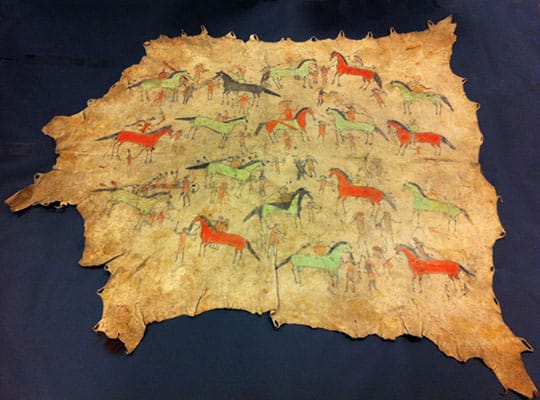
Pictorial Buffalo Robe
Created by a Crow artist, a member of one of many tribes in the plains area of North America, this work features a narrative story painted on the hide of a buffalo. As described on the Reading Public Museum website, "this extraordinary pictorial buffalo hide painting likely depicts a battle scene featuring more than 50 human figures and 18 green, red, and black horses. The scenes are arranged in register across the 'canvas' of the buffalo hide, above and below the central seam. The action ranges from warriors on horseback bearing circular shields, shooting arrows, and swinging clubs, to hand-to-hand combat and other skirmishes between enemies. There are at least three guns among the weapons pictured and one scalping scene."
Native Americans believed that animals were sacred and that all parts of an animal should be used upon its death. Thus, artists often used the hides of hunted animals as drawing surfaces on which to depict narratives. Once the painting was complete, the hide would often be turned into a robe as was the case with this work. This shows how artistic creation and utilitarian function were often linked for Native American artists. Often worn by high-ranking people such as chiefs, spiritual leaders, and honored members of the tribe, such robes, according to the Reading website, "were worn wrapped lengthwise around the body, and the painted designs were visible in cold weather, when the fur was turned to the inside."
Buffalo hide, paint - Reading Public Museum, Pennsylvania
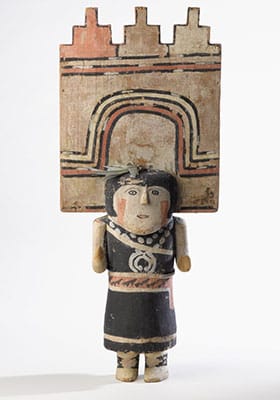
Kachina Doll (Polimana)
A work of the Hopi Pueblo tribe, this small doll figurine, known as a Kachina, features an elegantly dressed woman. She wears a belt, beaded necklace, and elaborate, oversized headdress. Kachina dolls like these were made by Pueblo artists for use in ceremonies and thus indicate the vital role that art played in the spiritual lives of the cultures they served.
According to the website of the Brooklyn Museum, a Kachina is "a supernatural being that represents a life-force or embodies a natural phenomenon such as the sun, the moon, a plant, or an animal .. Such beings have the power to control rainfall, crop growth, and fertility; to cure and protect; and to act as messengers between the gods and human beings. Carved kachina figures, also known as kachina dolls, are representations of these spirits and can have a sacred or an educational purpose. During some ceremonies, the carvings are given to community members to reward virtuous behavior, recognize a recent marriage, or teach children about religion."
As with much Native American art, works like these were once solely for intra-tribal use but became prized and fetishized objects to outsiders. Recognizing a new audience for their work, some artists began to create objects with more detailed and ornate decorations, suitable to a market looking for collectibles and curios. According to Janet Berlo and Ruth Phillips, "although most late nineteenth-century Kachina dolls were simple painted effigies, today, many are richly adorned with additional materials, including feathers, turquoise, cloth, and rawhide. The twentieth century has also brought an increased realism of pose, with 'action figures' mounted on a wooden base and caught mid-step in a dance pose."
Wood, pigment, cotton, feathers - Brooklyn Museum, Brooklyn, New York
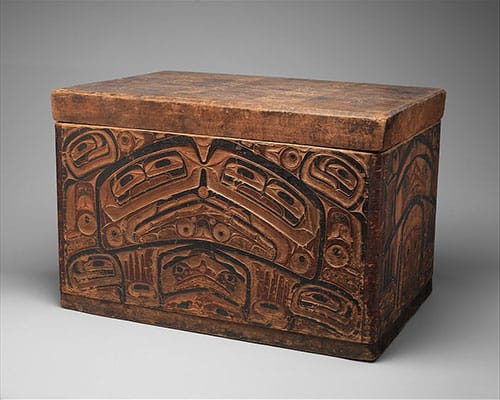
Storage Chest
This elaborately carved wooden chest is an important example of the Tlingit form-line tradition of carving and design. While created as functional objects, works like these show the importance of creativity in the day-to-day life of Native American tribes, in this case the Tlingit peoples.
The front of the chest, as the Metropolitan Museum of Art notes, features "a broad, frontal face with bared teeth and tongue...indicated in black outline. The abstracted face has two double-eyes and elaborations of faces located in the inner eye sockets. Its tongue hangs from a gaping mouth, split into two rounded ovoids (egg-shaped shapes). Underneath the face, a human form emerges, positioned between two upright hands painted in red. Salmon-trout-head ovoids are placed as space fillers at each of the four corners. These small ovular forms and rounded ovoids are echoed throughout the copiously decorated surface. The lateral sides of the container are each embellished with a painted elongated figure with two upright hands. Select features of the figure are further emphasized by fine hatching."
As David Penney explains, work like this chest reflect a combination of formal discipline and expressive freedom. "[F]orm-line designs can be painted, carved in shallow relief, or often both. The form-line tradition is a conservative discipline and master artists rarely transgressed the rules. Within the system, however, they found great opportunities for their skills and creativity." Penney notes that, "[b]y observing carefully how form-line designs were created, art historians have been able to recognize the hands of individual masters even when their names are no longer known."
Wood, paint - Metropolitan Museum of Art, New York
Super Indian No. 2
In this bold and satirical painting, twentieth-century Native-American artist Fritz Scholder depicts a large Indian man, seated, wearing a headdress and jewelry while holding an ice-cream cone. The brash block colors and somewhat crude outlines and shapes give the work a Pop-art quality. According to Jordan Steffan, pieces like this "thrust contemporary styles into a genre dominated by what Scholder characterized as 'flat' and, at times, disingenuous depictions of Native Americans. His paintings disrupted comfort zones - even for Native Americans - by rawly exposing issues including alcoholism, unemployment and cultural classes."
An Indigenous artist, for many years Scholder avoided his heritage or any themes depicting Native American life or history, choosing instead to follow the Abstract Expressionist and Pop Art movements of his era. This work, however, and others like it, document a marked shift. According to Steffan, while working as a teacher in 1967, Sholder grew frustrated with his students' "inability to create an 'honest' representation of current American Indians. So he carried his brushes and paints into the studio classroom and quickly filled the canvas with the figure he pledged to avoid. The same subject that would eventually define his works. Scholder's decision to break his promise marked a fierce turning point for campaign on behalf of Native American rights and for American Indian artists."
This work indicates the political animus of much contemporary Native American art: its use to address historic injustices and challenge cultural stereotypes. David Penney notes that Scholder's imagery represents "an abrupt departure from the safe and distant nostalgia of earlier generations of pictures. Irony, always present in the historic relations between Native Americans and the culture of conquest, steps to the foreground of the art, paralleling the rise of Native political activism."
Oil on canvas - Denver Art Museum, Colorado
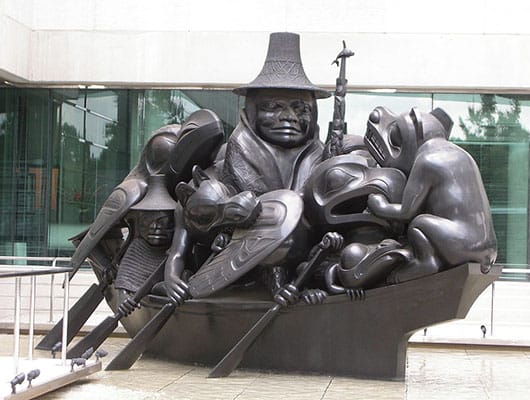
Spirit of Haida Gwaii: The Jade Canoe
An elaborately carved work in plaster and bronze, Spirit of Haida Gwaii is, according to Gerald McMaster, "the largest, most complex, and best known of Bill Reid's sculptures. The work depicts a canoe filled with thirteen entangled ethereal beings, the majority of whom are non-human and of mythical Haida origin: the Raven (Xhuya), the Wolf, the Eagle, the Frog, the Bear Family, the Beaver, the Dogfish Mother, and the Mouse Woman (Quaganjaat). The three humans aboard: the Bear Mother, the Chief (who sits at the centre holding his staff), and the 'Ancient Reluctant Conscript,' as Reid depicts him."
Bill Reid was a twentieth-century artist of the Haida people(based in the Northwest of North America). Works like this one indicate the influence that ancestral mythology held for him, as it does for many contemporary Indigenous artists of North America. At the same time, the piece is deeply personal, bearing an element of self-portraiture, As McMaster explains, "the sculpture has been seen as both a portrait of Reid himself and as a depiction of the condition of life on Earth as seen through his eyes. Of it he wrote, 'The boat goes on, forever anchored in the same place.'"
Speaking of the early Haida peoples, Reid wrote that "for many, many generations they grew and flourished, built and created, fought and destroyed, lived according to the changing seasons and the unchanging rituals of their rich and complex lives." With this sculpture Reid attempted to honor these traditions and document the struggles of his ancestors, linking the present and his own biography to the deep history of his land.
Plaster, bronze with patina - Vancouver International Airport, Canada
August Encampment
This semi-abstract painting by Salish and Kootenai artist Jaune Quick-to-See Smith explores memories of family reunions at a summer encampment in Montana, at the home of G.G. Kipp, a medicine person. The work reflects the artist's pleasure and fulfilment at reengaging with Native American traditions. Quick-to-See Smith recalls: "we lived in tipis, cooked outdoors and participated in ceremonies. It was a great social gathering of Blackfeet and families married into Blackfeet, all sharing news of Indian country, cooking together, sharing food, talking about Indian history, Indian politics and Indian survival." The visual symbols in the painting are intended to function like mnemonic devices, distilling memories of particular encampment experiences and activities.
Born in 1940 in Montana, Jaune Quick-to-See Smith creates work which draws on Native American identity, explores histories of oppression of Indigenous Communities in the United States, and presents a strongly environmental worldview. Her works often have a cartographical qualities, almost appearing as abstract maps of different scales, and she is also known for incorporating elements of collage. A consistent feature in her work is the use of visual symbols that represent elements of both traditional and modern culture, summing up an idea or archetype rather than a specific object, functioning like a pictorial language.
Quick-to-see-Smith is also known for making connections freely between Native American craft objects and customs and the artistic traditions of (white) North-American modernism, particularly Abstract Expressionism. She has said: "I look at line, form, color, texture, etc., in contemporary art as well as viewing old Indian artifacts the same way. With this I make parallels from the old world to contemporary art. A Hunkpapa drum become a Rothko painting; ledger-book symbols become Cy Twombly; a Naskaspi bag is Paul Klee; a Blackfoot robe, Agnes Martin; beadwork color is Josef Albers; a parfleche is Frank Stella; design is Vasarely's positive and negative space."
Oil on canvas - Metropolitan Museum of Art
Beginnings and Development
Early Development of Indigenous Art in North America
There is great diversity among the different groups of Indigenous peoples who populated or continue to populate North America. Each has its own timeline but it is believed that the earliest group dates back to 13,000 BCE. According to author David Penney, "the most widely accepted scientific view accounts for the peopling of the New World through migrations from Asia no more than 15,000 years ago when Siberia and Alaska were connected across the then-dry Bering Sea. Stone tools are the earliest objects that evidence human activity in North America. Archaeologists call the earliest Americans Paleo-Indians...and it is believed they may have woven baskets, painted hides, or worked with other kinds of ephemeral artistic media, but no evidence of such activity survives today."
Penney draws attention to the particular importance of so-called "Clovis culture," first identified at a site called Blackwater Draw near Clovis, New Mexico. Clovis culture "represents the earliest, broadly based cultural pattern identifiable within the currently known archaeological record of North America," Penney notes, adding that "Clovis sites date from 13,500 to 12,900 years ago and they are scattered across much of North America, from Wyoming to New Mexico, from New York State to Florida." The art created by Clovis culture was largely functional. What remains primarily consists of stone blades, bannerstones and weights used in burials.
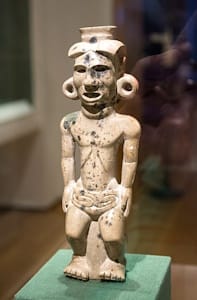
Several thousand years later, around 500 BCE, another group, the Adena people, came into existence. They survived until 100 CE, occupying present-day Ohio, Kentucky, and West Virginia during part of what is known as the Woodland period (roughly 500 BCE to 1100 CE). This group, the earliest to live in Eastern North America, are best known for their elaborate burial mounds. Excavations of these have led to the discovery of some of the earliest examples of pottery, as well as jewelry, blades, and smoking pipes. These pipes are believed to have been used in rituals and ceremonies and were often carved as effigies in the shape of humans and animals, thereby constituting some of the earliest sculptural works in North America.
Other early groups include the Mississippian tribes, who covered a vast area of North America from the southwest to the plains, thriving between 800 and 1600 CE. They also seem to have adopted a mound-building practice. Archaeologists have discovered many small carved figurines during excavations of relevant sites, as well as early examples of pottery. A third early Native American group, the Anasazi tribe, flourished from 100 to 1600 CE in the southwest of present day North America. The Anasazi were some of the earliest Pueblo peoples and, according to art historians Janet Berlo and Ruth Phillips, "the people we call Anasazi were the ancestors of modern Hopi, Zuni, and other Pueblo peoples." Their achievements in the arts, Berlo and Phillips note, "ranged from monumental architecture to ceramic technology, to painting on walls of vessels and walls of houses, to work in shell, bone and fibre."
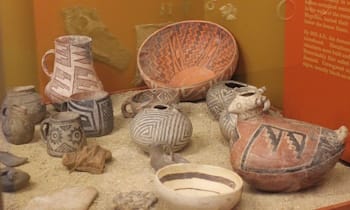
From early groups like these emerged hundreds of unique, individual tribes. Today, there are 574 federally recognized Native American tribes in the United States and more than 630 First Nations communities in Canada. A large part of what we know about early Native American life and art in North America can be biased as it is seen through the lens of the European settlers who took over the continent. It is important, then, to closely examine the art that these people made prior to this time of conquest, especially for the groups no longer in existence today.
The Indigenous peoples of the North American Arctic have also made art since the beginning of their existence, with animals a consistent theme. According to David Penney, one of the earliest groups, the Dorset culture, active between 500 BCE and 1000 CE, "committed a great deal of skill and craft to the task of creating images. They carved small pendants and figures of wood, antler, and walrus ivory: images of animals, human dolls with articulated arms and legs, and startlingly lifelike miniature masks."
Early Development of Indigenous Art in Central America
The three main Indigenous groups in what is loosely considered Central America include the Aztecs, the Mayas, the Zapotec, and the Olmecs. According to writer Christopher Minster, "the Olmec were the first great Mesoamerican civilization. They thrived along Mexico's Gulf coast, mainly in the present-day states of Veracruz and Tabasco, from about 1200 to 400 BCE .. The Olmec were great artists and traders who dominated early Mesoamerica in cultural terms from their mighty cities of San Lorenzo and La Venta. Olmec culture was greatly influential on later societies, such as the Maya and the Aztec.
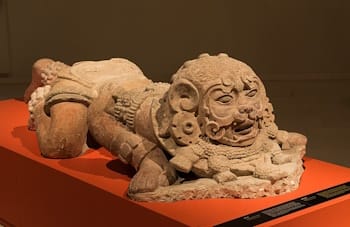
The Mayas, whose culture dates back to about 1800 BCE were, according to Minster, "an advanced Mesoamerican civilization living in present-day southern Mexico, Guatemala, Belize, and northern Honduras. Unlike...many other Indigenous American groups, the Maya were not one unified empire, but rather a series of powerful city-states that often allied with or warred upon one another." Minster notes that "Mayan civilization peaked around 800 A.D. or so before falling into decline." As the Maya civilization grew, so did its artistic production, with one of the most productive periods being the first millennium BCE.
During this time, according to authors Mary Ellen Miller and Megan O'Neill, "particular maya practices took root almost everywhere...including the carving of tall stone shafts, or stelae, and their placement with low cylindrical stones call altars today." Several white North-American and European explorers discovered this art and architecture in the 1800s, in the context of ongoing colonial expansion. They included Frederick Catherwood and John Lloyd Stephens, who helped to introduce the Maya civilization to the world.
The Zapotec civilization emerged around 700 BCE in the valley of Oaxaca in modern-day Mexico. The Zapotecs are noted for developing a calendar and logo-syllabic system of writing, one of the first writing systems of Mesoamerica. The famous ancient city of Monte Albán was at the center of a Zapotec state that enjoyed significant regional control for a time. There is evidence here of significant skill in architecture and statuary, including a pyramid complex and carved stone monuments dotted across the site. The Zapotec also created pottery, rugs, and relief friezes.
The last of the great Mesoamerican Indigenous peoples was the Aztec civilization. The Aztecs ruled what is present day Mexico from roughly 1300 to 1521 CE. A powerful and sometimes violent group, the Aztecs were able to establish their reign by militarily dominating other groups, establishing a complex society guided by a strong belief in the gods. According to author Mark Cartwright, because of the Aztecs' extensive written records, and because their civilization was extant during the Spanish incursions of the 1500s, "the Aztec civilization, with its capital city at Tenochtitlán (near Mexico City), is...the most well-document Mesoamerican civilization." Sources historians can draw on include "archaeology, native books (codices) and lengthy and detailed accounts from their Spanish conquerors - both by military men and Christian clergy."
It is important to emphasize a significant degree of cultural continuity between the major cultures of pre-Columbian Mesoamerica, with different civilizations trading and intermingling with each other. For example, there is evidence of Zapotec art being created for trade with the Aztecs. Given the havoc wreaked by European invasion on this part of the world, it is also important to note how crucial art objects are in making sense of the cultures of the region. Many Indigenous writing systems were destroyed, for example, so that many significant sources of knowledge about the past were cut off.
Early Development of Indigenous Art in South America
Interestingly, art from the Andes mountains of Peru in South America can be dated back to long before the first recorded civilizations emerged there. According to art historian Rebecca Stone, "Andean art has been preserved from at least 8800 BC; however, sophisticated art forms date from around 2500 BCE onward." The fact that textiles were among the refined artworks created from this point onwards distinguishes South American Indigenous art from the art of other early American cultures.
Clarifying the above point, Stone explains that, "in contrast with many other world cultures, textiles preceded fired ceramics by millennia in the Andes. Ten-thousand-year-old basketry from Guitarrero Cave, the earliest so far from South America, nine-thousand-year-old twined mats from the Chinchorros culture of northern Chile, and the sophisticated five-thousand-year-old twined cloths from Huaca Prieta demonstrate how early and elaborately the fiber arts developed, well before loom technology was invented." Stone notes, by contrast, that "[i]t is comparatively late, only around 1800 BC, that heat-hardened clay becomes an important practical and aesthetic material."
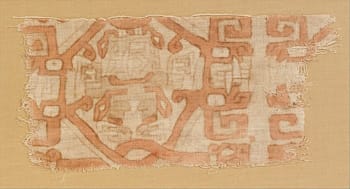
It is not clear how civilizations rose and fell in South America. But it is believed that the earliest Indigenous group was the Chavín people, who lived in the Andes mountains of Peru from 900 to 200 BCE. In their art, as in all South American Indigenous art, we find an emphasis on nature and the spiritual, with likenesses of gods and shaman figures very common. A few centuries later, the Moche people dominated the region, from 100 to 700 CE. The Moche were succeeded by the Tiwanaku and Wari, who thrived between 600 and 1000 CE, before the Chimú civilization emerged around 900 CE.
The Chimú were replaced by the Incas, the most well-known and dominant Indigenous group to inhabit South America. A powerful and influential civilization, they dominated the area from 1400 to 1533 CE until they were conquered by European invaders. The art produced by the Incas was wide-ranging and elaborate, covering a variety of media including ceramics, metalwork, and textiles. Incredibly elaborate architectural structures were built for housing and worship.
Concepts and Styles
Themes and Trends in North American Indigenous Art of the Southwest
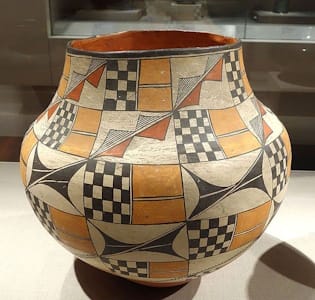
The Native American tribes that dominated the southwest of North America are primarily known as Pueblo cultures. According to Janet Berlo and Ruth Phillips, "the principal ancient cultures are the Hohokam of Southern Arizona, the Mimbres/Mogollon of Southwestern New Mexico, and the Anasazi of the 'Four Corners' region - where the states of Arizona, New Mexico, Colorado, and Utah converge." Today the key cultures descended from these ancestors include the O'odham, Hopi, Zuni, Acoma, and the Rio Grande Pueblos.
The earliest artforms perfected amongst these communities were painted pottery and fiber arts. According to Berlo and Phillips, "among the earliest known artistic artefacts from the Southwest are objects made of twined, coiled, and woven plant fibres. Indeed, the term 'the Basketmaker Culture' has long been used by archaeologists to describe the ancient Pueblo peoples." Pottery was also perfected early on with the creation of elaborately detailed painted bowls.
While in the beginning these pieces were largely utilitarian in purpose, eventually the works became more ornate and decoratively painted, which made them better for trading. According to David Penney, "by the twelfth century, potters used large kiln sites near sources of firing fuel yet distant from residences. Specialized artists, perhaps extended kinship groups or dedicated communities, made the pots and supervised these massive and technically challenging firings. Decorated pottery circulated widely through trade and local potters emulated popular styles and techniques but with their own local variations."
A few centuries later a focus on jewelry-making emerged, with the Navajo becoming particular experts in silver-work. As Penney explains, "early Navajo smiths worked silver with simple casting and annealing techniques, adding decorative markings with files and straight chisels....Later generations introduced the techniques of smoldering, mounting stones of turquoise, and the use of decorative stamps...." He notes that "[t]hroughout the twentieth century, styles changed and workmanship became increasingly sophisticated, using large cut or irregular pieces of polished turquoise set in massive bracelets, necklace pendants, concha belts, brooches, and bolo ties."
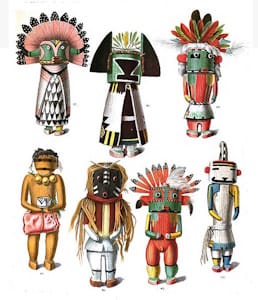
Indigenous artists also made many works to be used in rituals and ceremonies, including the all-important Kachina ceremonies, during which the spirits of ancestors (known as Kachinas) were honored and their blessings sought. Art played a vital role in these activities. According to Penney, "among both the Hopi and Zuni, men carve small dolls of cottonwood root painted or dressed to represent one or another of the Kachinas. Traditionally, these are given to young girls as rewards for exemplary behavior."
As with many regional variants of Indigenous North American art, many modern and contemporary artists have developed practices which respond to historical traditions. For example, the painter and sculptor Dan Namingha is a member of the Hopi Tribe based in Arizona. His clean-edged, minimalist paintings, which bear resemblances to the work of Georgia O'Keeffe, are partly a way for him to engage with Hopi symbolism and explore connections between the material and spirit world. The potter Helen Cordero, meanwhile, based in New Mexico, was a member of the Cochiti Pueblo community and is credited with developing a new style of figurative clay sculpture, the Pueblo Storyteller Doll. Respecting traditional methods, Cordero would dig for her own clay and source her own natural pigments. The "singer mother" doll is particularly associated with her work.
Themes and Trends in North American Indigenous Art of the Artic
As David Penney notes, the Indigenous art of the North American arctic was dominated by carved likeness of animals, including pendants and figures in wood, antler, and ivory, as well as human figures and masks. Certainly, this was the case for the Dorset culture that thrived between 500 BCE and 1000 CE. Penney notes that "[f]or the challenging, risk-laden lives of Dorset people, these pendants and amulets may have represented a spiritual technology, a means to influence the world around them." Penney adds that the "keen observations of animals" in Dorset art suggests "an ideology that perceived few boundaries between the activities of human beings and of the other creatures of the environment."
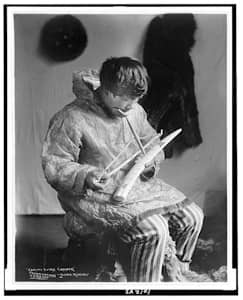
Highly developed carving skills are notable in much of the art of later Arctic groups such as the Eskimos of Alaska and the Inuit tribes of Canada and Greenland. Often forged from ivory, the earliest pieces these groups made included both functional tools and elaborately carved amulets. Hats used for ceremonies were also carved from ivory.
More recently, as outsiders noticed their skills, Arctic craftspeople began to create works for purchase outside their community, such as tiny sculptures of animals and human figures. According to Janet Berlo and Ruth Phillips, "by far the most widespread artefacts made for sale were ivory carvings which grew out of an indigenous Iñupiaq tradition of carving walrus tusks and engraving them with small-scale pictographic scenes."
Inuit culture is particularly notable for the wealth of modern and contemporary artists it has fostered, across a range of styles. For example, Germaine Arnaktauyok (born in modern-day Greenland rather than the Americas, a border not recognized by Inuit territories) is known for her spirited figurative lithographs and etchings, featuring fine color gradients and bulky yet graceful human and animal forms. The sculptor and collagist Floyd Kuptana, meanwhile, an Inuvialuit artist of the Canadian arctic, developed a colorful, abstract style comparable to the raw vibrancy of Art Brut or Jean-Michel Basquiat. Another artist based in Canada, Annie Pootoogook was known for her consciously childlike felt-tip-pen drawings exploring modern life in the Inuvialuit community of Kinngait.
Themes and Trends in North American Indigenous Art of the Northwest Coast
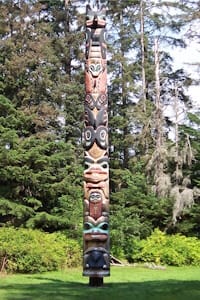
Dating back to 500 BC, there are many Native American tribes in the Northwest of North America, including California, Oregon, and Wyoming, as well as parts of Alaska and Canada. Some of the most active today include the Tlingit, Haida, and Chinook peoples. The Northwest Coast was an area rich in art. Much of the work made by Indigenous artists from this area deals with issues of identity and the past, often showcasing the carving skills in which these peoples excelled.
According to David Penney, "on the Northwest Coast, images created by artists stand in testimony to claims of ancestry and to the material and social rights of family groups. Anthropologists call this kind of image a 'crest,' and the concept pertains equally to the Tlingit, Tsimishian, and Haida peoples." But a crest is "more than just an image," Penney explains. "A crest is composed essentially of three things: a proper name, usually referring to an animal or spirit creature; a story or history that explains a family's relationship to that creature; and an object, such as a crest hat, a decorated robe, or a house post, which displays an image of the animal or spirit being and by doing so evokes the story." It is through the rendering of an art object that the crest, which has a multidimensional character, finds tangible form.
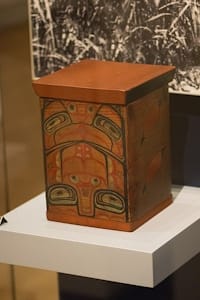
Carving skills were also employed in the making of daggers, rattles, and masks, all of which were used in rituals and ceremonies, including the highly important Kwakiutl potlaches. Carving is equally important in the rendering of other art-objects such as totem poles, chests, and boxes, which often include almost abstracted depictions of animals in interesting patterns rendered in a style known as "form-line tradition" unique to these groups of Indigenous peoples. Form-line designs were also incorporated into elaborate woven textiles and hand-painted onto various objects.
According to author Clara Miller, form-line was "a Tlingit, Haida and Tsimshian design style, which can tell stories, like of historic events. It often features animals and supernatural beings in abstract form, as well as other images. Formline seeks balance and symmetry. There are three primary colors used: red, black, and a blueish green. Formline is two dimensional when on objects like bentwood boxes and clan hats, but can also be adapted for totem poles and masks."
Contemporary artists of the American northwest who have developed the indigenous traditions of their communities include the Haida sculptors Bill Reid and Robert Davidson. Both are notable for creating modern variations on traditional indigenous symbolic motifs in three dimensions, exploring formats such as the totem pole while working in a flowing abstract style with bold colors that recalls the European modernism of the early twentieth century. Davidson was apprenticed to Reid, showing the ways in which traditional symbolism and compositional approaches continue to be passed down.
Themes and Trends in North American Indigenous Art of the Plains
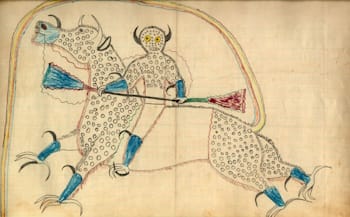
The tribes of the North American plains, which include the Cheyenne, Cree, and Lakota peoples, cover a vast geographical area including the states of Texas, Kansas, Mississippi, Iowa, Montana, and Wyoming and parts of Canada. Possessing a long and rich history of artmaking, these groups' earliest known works are rock paintings on cave walls dating back to at least 900 BC. A desire to record episodes from the life and history of the people is a dominant feature in much art of the plains, as in the many narrative works created by artists of recent centuries to display on shields and clothing.
Art also had an overlapping, protective spiritual function for many artists of the plains. A craftsperson might, for example, capture what they saw in a dream state on an object which would then be used in ceremonies and rituals. According to David Penney, "the design painted on a shield showed the identity of the owner's spiritual protector....The powers of the cosmos also found expression on painted garments worn by adherents of the Ghost Dance during the late 1880s and 1890s....Similar garments made by the Lakota were believed to have had the ability to stop bullets."
Individual figures are often not afforded much significance in plains art. Often rendered in a simple, stick-like style, they are less important than the narrative in which they are included. The story is often depicted using dotted lines to show paths traveled by figures and animals involved in rituals, battles, or hunts. As time passed, plains narrative drawings began to be captured on paper as well as on functional and ritual objects.
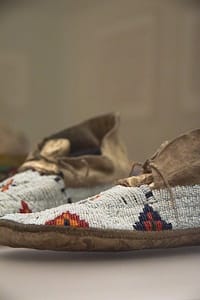
Beadwork was also an important art-form for the Plains Indians, often considered a style of artmaking intended for women, as Penney explains. "[B]y the 1860s, Plains women had a broad range of different-colored, smaller-sized 'seed-beads' to choose from. Color preferences, traditions of technique for application, and choices about design, form, and structure among women of different communities developed into far more strongly articulated 'tribal styles' during the 1860s and 1870s. Parallel stitch favored by Cheyenne women, for example, with beads applied within parallel lanes, derived from the techniques of porcupine quill appliqué but enlivened by patterns of alternating colors within the lanes. Crow women of Wyoming and Montana, on the other hand, developed their own particular 'Crow stitch' technique .. Beadwork grew to become the dominant medium for the decoration of Plains garments, bags, pouches, horse and tipi ornaments, and several other categories of objects."
Plains Indian art has many living strands today. Indeed, many contemporary artists can lay claim to Plains ancestry and work with the symbolism and compositional approaches of Plains Indian culture. Born in Montana, Jaune Quick-to-See Smith is an activist and artist of the Confederated Salish and Kootenai Tribes noted for her abstract landscapes and cartographic works, incorporating elements of collage and comparable to the rough-edged Pop Art of Robert Rauschenberg and Jasper Johns. T.C. Cannon, a member of the Kiowa Tribe, is another artist with affinities to Pop Art. He used his work to explore the clash of contemporary and traditional culture in twentieth-century Native American life, and to interrogate white stereotypes of Indigenous cultures.
Themes and Trends in North American Indigenous Art of the East
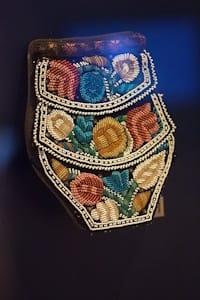
Indigenous tribes of eastern North America include the Cayuga, Cherokee, Huron, Iroquois, Mohawk, and Seneca. As well as dominating the east coast of the continent their influence stretched inland to the Great Lakes of the modern-day United States and Canada. Some of these tribes date back to the Eastern Woodland period and have an artistic tradition that is rooted in prehistoric times. As for many Native American cultures, woven baskets and pottery were amongst the earliest artworks produced.
The art these communities created was influenced in later centuries by the arrival of European colonists. According to author David Penney, "the fashions of dress, design, and decorative technique throughout the Eastern Woodlands altered, as makers responded with vigor and creativity to the opportunities of new media offered by trade. Glass beads, silk ribbon, wool and printed cotton cloth, silver ornaments, and other materials required new techniques and working methods, and offered new possibilities for design and ornament." It was at this time that floral designs also began to appear and came to dominate much of the native garments produced. According to Janet Berlo and Ruth Phillips, these were inspired by and even "borrowed from the art of European and North American immigrants."
Still, Native American artists did not directly copy European designs. Instead, as Berlo and Phillips explain, "one of the most striking aspects of the artistic traditions that developed during the nineteenth century is the originality of Native beadworkers' interpretations of these designs. None of their realizations of floral designs in media as diverse as porcupine quillwork, beadwork or silk embroidery is stylistically identical to a European prototype."
Notable contemporary artists of Native American descent who are based in eastern North America include Marie Watt and Kay WalkingStick. Watt, a member of the Seneca Nation, has explored and developed Native American textile arts through her practice. Her hangings and installations are bold and abstract, incorporating everyday objects as well as unusual materials such as alabaster and slate. WalkingStick, a Cherokee, has produced striking abstract landscape works, often using oil on wooden panels and working in a diptych format.
Themes and Trends in Olmec Art
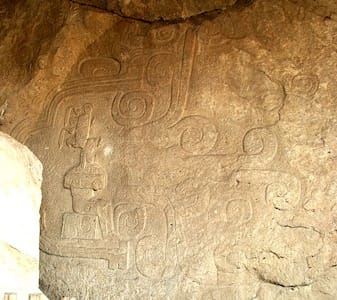
While the Olmec civilization does not exist today, their art and artmaking techniques made a unique contribution to Mesoamerican Indigenous art, particularly in their preferred medium of stone, which they shaped into both freestanding sculptures and reliefs. The Olmecs were capable of working in a range of dimensions, as can be seen from their most memorable works, a series of massive stone heads, as well as small figural works rendered in various poses and costumes. These figures included depictions of individuals from Olmec society, and also of children and babies. Representations of royals as well as gods were also common. Monarchs and deities can also be found in the carvings and rock paintings located in present day Morelos, Mexico.
Themes and Trends in Maya Art
The Maya civilization was considered an advanced one. This was partly because of their complex written language, which, according to Mary Ellen Miller and Megan O'Neill, "distinguished the Maya from all other New World peoples." At the beginning of the twentieth century, Miller and O'Neill note, "scholars came to place the Maya at the apex of New World cultural development." But their perceived sophistication was also rooted in the art and architecture they produced.
The fact that the Mayas were not based in one location had an impact on their varied and sophisticated creative work. Miller and O'Neill state that "much Maya art is site-specific, both in the current sense of being designed for a particular architectural space, but also in the sense of being made within a particular regional school." The rainforest which surrounded them, for instance, was put to good use, with much of their work being made of wood. But various materials from the earth and the wildlife surrounding human communities were also incorporated into their practice, including shell, stone, jade, turquoise and animal bones.

One recurring theme in Maya art is the veneration of gods and royalty. According to Miller and O'Neill, "Maya art is an art of the court and its retinue, in large part celebrating royalty, nobles, and wealthy merchants, and the women, musicians, and artists who lived with them or served them. The Maya elites lived well, and their world was one of both perishable and permanent art." The rarefied contexts in which art was made had an impact on how it was used and displayed. "Much Mayan art was made to adorn wealthy individuals, from jade and obsidian ear flares..., to elegant mosaic masks that would transform the dead with permanent form."
Art could have other uses too, Miller and O'Neill note, "[i]n addition to depictions of royal figures carved in stone." "[T]he subjects of marriages and extended family also figure broadly, as do the communications between humans and the supernatural." These themes manifested themselves in a variety of formats, including large stone reliefs or stelae, large-scale wall paintings and much smaller paintings and carvings on bones, ceramic objects, sculptural figures, and jewelry and textiles.
Unlike other cultures of Meso-America, whose artistic traditions did not survive the demise of the relevant civilizations, we can see traces of Maya influence in much modern and contemporary art. Maya culture has been particularly associated with the Zapatista revolutionary political movement in Mexico, thus many works of political art such as murals and wall paintings are influenced by Maya style - such as the practitioners of the Mexican Muralism movement.
Notable contemporary artists from Maya-descended communities include Maruch Sántis Gómez, a photographer and member of the Tsotsil group based in rural Chiapas, where the Zapatista movement is strong. Gómez uses photography, written testimony, and other media to record and venerate the spiritual beliefs and social customs of her culture.
Themes and Trends in Aztec Art
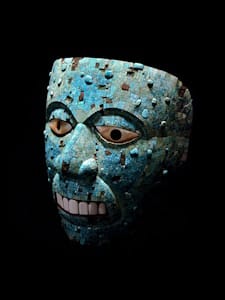
There was great diversity in the subject and type of art made by the Aztecs. Perhaps this is because, more so than any of the other Mesoamerican Indigenous groups, the Aztecs had a more formalized social stratum dedicated to the making of art. According to Mark Cartwright, "Aztec art was nothing if not eclectic and ranged from miniature engraved precious objects to massive stone temples....Organized in guilds and attached to the main palaces, artisans could specialize in metalwork, wood carving or stone sculpture, with materials used such as amethyst, rock crystal, gold, silver, and exotic feathers."
Cartwright goes on to outline some of the most common and enduring qualities of Aztec art. "Perhaps some of the most striking art objects are those which employed turquoise mosaic such as the famous mask of Xuihtecuhtli." He adds that "Aztec art depicted all manner of subjects but especially poplar were animals, plants and gods, particularly those related to fertility and agriculture."
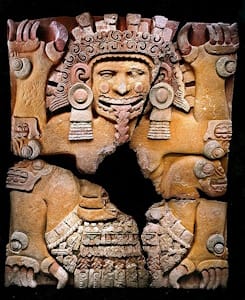
Among the more unique aspects of Aztec art was its use of human blood. Human sacrifice was important within Aztec culture, serving a legitimate and profound spiritual function. The use of blood from these sacrifices in artworks was often a way of further honoring gods and ancestors. According to Mary Ellen Miller, "the Aztecs captured the representation of gods in stone and wooden images .. The ability of human blood to sustain ancestors and to nourish gods is embedded in many Aztec works of art. These references are not metaphorical: one Spanish soldier, Andrés de Tapia, [was so disturbed by his discovery that he] described the experience of seeing a large and terrifying sculpture encrusted with jewels, gold, and human blood." Even when human blood is not actually used to make the art, many Aztec sculptures and carved reliefs feature depictions of flowing blood related to sacrificial themes.
Themes and Trends in Indigenous South American Art: Chavín, Moche, Tiwanaku and Wari, and Chimú Civilizations
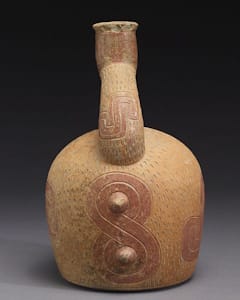
The early, Indigenous civilizations of South America created a wealth of art, with great stylistic variety amongst different groups. The most ancient of these peoples, the Chavín, focused heavily on animal representations, and on links between animals and divine powers. According to Mark Cartwright, "Chavin art is full of imagery of felines (especially jaguars), snakes, and raptors, as well as supernatural beings, often with ferocious-looking fangs. Creatures are often transformational - presented in two states at once - and designed to both confuse and surprise."
Pottery, an important art form in South America, also had its roots in the Chavín civilization. The most recognizable object associated with this tradition is a form of stirrup-spouted, bulbous vessel, which, according to Cartwright, would often feature "polished raised designs depicting imagery from Chavin religion." He adds that "[v]essels could also be anthropomorphic, typically of jaguars, seated humans, and fruits and plants."
While the Chavín civilization was extinct by around 200 BCE, their art laid the foundation for future creative developments in the region. According to art historian Rebecca Stone, "portable art plays this distilling, didactic role not only during its own time, but even continues to do so in later periods. In fact, Chavín art had a long life after its time: the stirrup-spout form pervades many subsequent Andean ceramic styles."

The art of a later Indigenous group, the Moche culture, which dominated Peru between 100 and 800 CE, was heavily influenced by the Chavín civilization. Artworks anchored in storytelling were of particular importance to the Moche people. According to Stone, "Moche art may be characterized as very active, with stronger interest in narrative than other Andean styles. Bodies are shown with almost frenetic energy, flying across the landscape, limbs cocked at sharp angles. Moche art seems 'transitive' because so often an action is perpetrated on something: sea lions are clubbed, prisoners are taken by the hair, tied, and bled, and shamans become owls....The rich tomb findings...have shown us that the stories laid out on murals and wrapped around stirrup-spout vessels had a reality to them." Many of the vessels Stone refers to also bore images of actual people, making them an early form of portraiture.
The treasures found in the burial grounds described above have revealed Moche artists' expertise across a variety of media. As Mark Cartwright explains, "the Moche were gifted potters and superb metalworkers, and finds include exquisite gold headdresses and chest plates, gold, silver, and turquoise jewelry (especially ear-spools and nose ornaments), textiles, tumi knives, and copper bowls and drinking vessels. Fine pottery vessels were usually made using moulds, but each was individually and distinctively decorated, typically using cream, reds, and browns."
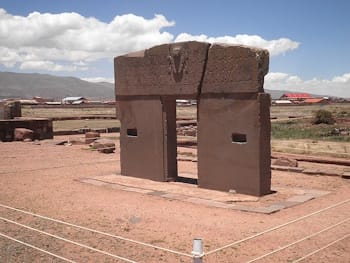
The Tiwanaku and Wari empires reigned simultaneously across the Andes during the period known as the Middle Horizon of South America, between 600 and 1000 CE. While one group could not help but be influenced by the other, as trade was an important part of their lives, the art each created was distinct. The architectural structures of the Tiwanaku, for instance, including their temples, were intended to display large-scale carved works, including monolithic sculptures of figures. The famous Tiwanaku Sun Gate, a decorated portal featuring a relief carving of the sun god, surrounded on either side by worshipping figures with bird and human heads, is an extraordinary, lasting monument to their prowess as builders and designers.
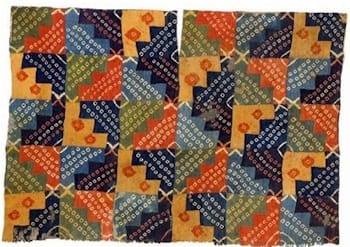
Wari artists, on the other hand, are perhaps best known for their amazing skill in textile arts. Intricately patterned with geometric shapes, dyed with a variety of earthy colors, Wari textiles were used as mantles and tunics. Showing the mutual influence of Wari and Tiwanaku cultures, these tunics, according to Stone, often "bore the rather circumscribed iconography seen most clearly on the [Tiwanaku] Sun Gate, concentrating mainly on the puma- and condor-headed shaman profiles."
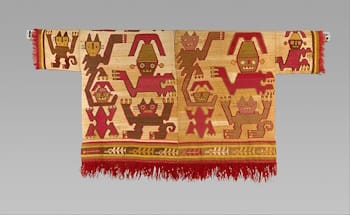
A later South American civilization, the Chimú (the dominant Indigenous group from 900 CE until the rise of the Incas), continued this rich tradition of textile making. According to Stone, Chimú textiles "often feature matched sets of brocaded lightweight garments, including wide shirts with sleeves, loincloths, and mantles. Chimú ground cloths can be differentiated form the other Late Intermediate Period styles by a telltale technical feature: pairs of warp threads travel together in the plain weave structure." Chimú textile imagery included "relatively simple, bold versions of profile and frontal crescent-headdress figures...often repeated, depicting the upper class and royalty in living color."
But it was the decorative embellishments of their textiles that distinguished the Chimú from other groups. As Stone explains, "even more prestigious than woven textiles were feather-covered and appliquéd-gold garments. Brilliant tropical feathers acquired via the extensive trade network were sewn in rows to plain-weave cloth backings. Even more shimmering are the plain-weave tunics covered entirely in tiny gold squares, as many as 7000 on a single example."
Although many of the civilizations explored here have not survived, traces of their artistic and architectural inheritance can be found in contemporary South American culture. For example, the Bolivian city of El Alto, located on the Altiplano Highlands, is known as the hub of Neo-Andean architecture.
Themes and Trends in Inca Art
The most well-known and influential of all Indigenous South American artists are those from the Inca civilization. Dominating the Andes from 1450 until their destruction by European settlers around 1550, according to Mark Cartwright, Inca artists, "produced some of the finest works ever crafted in the ancient Americas. Inca art is best seen in highly polished metalwork, ceramics, and, above all, textiles, which was considered the most prestigious of art forms by the Incas themselves. Designs in Inca art often use geometrical shapes, are standardized, and technically accomplished."
Inca artists distinguished themselves from their predecessors partly by what they chose to depict. As Cartwright explains, "both Inca pottery decoration and textiles did not include representations of themselves, their rituals, their military conquests, or such common Andean images as monsters and half-human, half-animal figures. Rather, the Incas almost always preferred colourful geometrical designs and abstract motifs representing animals and birds."
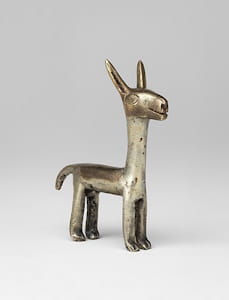
Where more realistically rendered animal and figural designs did appear is in the small, gold and silver figurines discovered in Inca tombs. These are believed to have been used in ritual ceremonies and offerings. According to Rebecca Stone, they were "painstakingly constructed from as many as eighteen sheets of metal, others cast. Because of their importance for survival and as ritual offerings, camelids are a frequent subject."
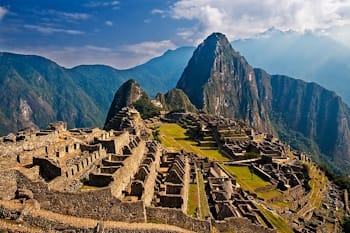
The Incas' skills in architecture are also important to note. An interest in large and intricately designed stone buildings had its origin in the Inca belief system, Stone notes: "the profound Inca sense of unity with the earth, especially their rocky highland homeland, took to a new level the Andean identification with nature. The Incas felt people were actually interchangeable with stones, believing them to be able to transform into one another."
Arguably the most impressive work of Inca architecture is the settlement of Machu Picchu, which includes more than 200 residences and temples. The UNESCO website notes that the "structures making up this outstanding religious, ceremonial, astronomical and agricultural centre are set on a steep ridge, crisscrossed by stone terraces". Appearing as if carved out of the mountainside itself, the mysteries that still surround this site are as engaging as the established facts concerning its creation. As the UNESCO site states, "[t]o this day, many of Machu Picchu's mysteries remain unresolved, including the exact role it may have played in the Incas' sophisticated understanding of astronomy and domestication of wild plant species."
Later Developments and Legacy
Legacies of the Indigenous Art of North America
The reception of North-American Indigenous art in the colonial west has a complicated history, beginning with the European exploration and invasion of the continent from the late fifteenth century onwards. These settlers, including the Spanish and English, influenced what artists were making and why. For example, their desire for Indigenous art objects resulted in spiritual objects being turned into commodities and souvenir-like collectibles, purposes for which they were never originally intended.
Later policies such as the Indian Removal Act of 1830 in the United States and the Indian Act of 1876 in Canada resulted in the displacement of thousands of Indigenous peoples, disrupting their way of life and impacting on how native traditions of artmaking were handed down. Speaking of this complicated history and its impact on modern Native American art, Janet Berlo and Ruth Phillips state that "the modern trade in Native art turns on this aspect of doubleness. On the one hand, the market for Indian art grew in tandem with the entrenchment of assimilationism and the dogma of the Vanishing Indian. Yet on the other hand, the commodity most desired by buyers - themselves displaced and alienated by many aspects of industrialization and urbanization - was 'Indianness' itself."
The authors continue that, "for Native artists, the increased commerce in art stimulated by [colonial] attitudes provided one of the few safe spaces for the expression of Native identity and the articulation of traditional beliefs and values. The same assimilationist policies that so gravely threatened their cultural survival also led to the establishment of Indian schools, some of which provided instruction in Western art techniques and led eventually to the establishment of specialized institutions for the training of Native artists. In the early twentieth century these three factors - the expansion of the market, the anti-modernist orientation of non-Native consumers, and scattered but crucial opportunities for training in Western art - came together to create the conditions for the full-scale emergence of a Native tradition of fine arts."
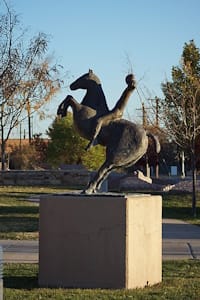
Today, Indigenous artists of North America create art for a variety of reasons and under many different influences and circumstances. Some remain deeply inspired by the legacy of their ancestors and continue to create work for ceremonial and cultural use within their own societies. Some try to fight against the "souvenir-style" works that are desired by collectors; while others embrace it.
There are also artists who create works in more modern styles and media, addressing contemporary themes. Among this group, some claim little or no Indigenous cultural influence, while others use media such as painting, sculpture, installation, and film to address historical injustices and attempt to challenge stereotypical views of Indigenous cultures. Some of the latter qualities can be seen in the work of modern and contemporary Indigenous artists such as Rebecca Belmore, James Luna, T.C. Cannon, Jane Ash Poitras, Fritz Scholder, and many others.
Many Native Americans of southwestern Pueblo cultures have continued to create art with roots in their communities' earliest ancestral origins, such as in the Anasazi tribe. However, these artists continue to make pottery, textiles, and jewelry, most have contemporized their work to appeal to outsiders looking for "authentic" Native art. According to Berlo and Phillips, "in the early years of the twentieth century, commercialization of Native silverwork, because of the increase in tourism, opened vast new markets for Pueblo and Navajo silversmiths. Today the making and marketing of jewelry is one of the economic mainstays of indigenous life in the Southwest." Important Pueblo artists of recent decades include the Cochiti potter Helen Cordero.
The legacy of the early Indigenous peoples of the Artic and their artmaking traditions, such as carvings in stone, ivory, and bone, has influenced the work of contemporary Inuit artists working today. According to Berlo and Phillips, once Inuit peoples were forced into settlements by Canadian and European governments, "the modern practice of making sculpture, prints, and drawings for sale to outsiders was soon established in these settlements. For around fifty years now, in many Artic communities the making of art has become a defining feature of Inuit life. In most instances, art has been marketed through a local community co-operative."
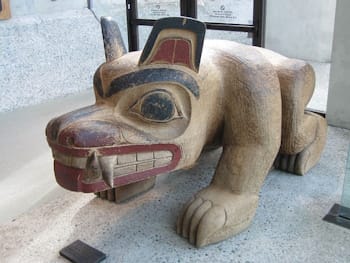
The form-line tradition of artmaking, like the carving skills of the early Indigenous peoples of the Northwest Coast, is still employed today. While the relevant works have been brought up-to-date and artists have taken advantage of a strong demand for Native art amongst outsiders, creators have also been governed by a sense of commitment to ancestral traditions. According to Berlo and Phillips, "during the first half of the twentieth century a number of Northwest Coast artists continued to make traditional art for use in potlatches. They and others also used traditional imagery to make model totem poles and other miniatures for the souvenir trade....Some carved masks...continue to display inherited family privileges at potlaches, while others are collected and marketed as 'fine art' by urban galleries." Artists such as Bill Reid, a Canadian Haida artist, incorporate native heritage and ancestral stories into contemporary sculptures and carvings.
Tradition is at the heart of many contemporary plains artists' practices, which draw on ancestral talents and knowledge, as in the modern-day schools of Plains Indian beadwork. Taking one contemporary example, David Penney notes that "most beadwork produced on the Lakota reservations [now] goes to powwow dancers, whose elaborate and meticulously made regalia provides a real advantage in competitive dancing. The growth and proliferation of powwow dancing after the 1950s throughout 'Indian Country'...reaffirm[ing] the importance of decorated regalia as a symbol of Native cultural identity and vitality, providing the occasion and performative structure for its display."
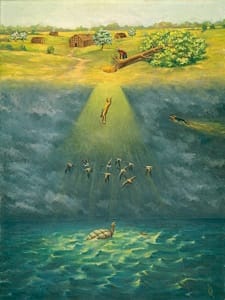
Indigenous artists of eastern North America working today have also built on the legacy of their ancestors. Many of their Native art-forms, such as bags, moccasins, and garments detailed with beadwork, are highly sought after. This has provided continuous demand for work and offered a gateway into modern artmaking approaches. According to Berlo and Phillips, "although the advent of a new modernist aesthetic in the twentieth century caused the popularity of Indian fancy wares to wane, the production of art commodities and souvenirs remained an important outlet for Native artistry during the first half of the twentieth century, and a vital link to the emergence of a new contemporary art of easel painting, printmaking and sculpture among Woodlands artists such as Ernest Smith during the mid-twentieth century." Relying on the same traditions and ancestral stories that guided his ancestors, Smith and others like him brought, and continue to bring, these stories to life on the canvas.
As well as describing the legacies of North American indigenous art by theme, it is possible to consider artists in relation to the region and tribe or nation they claim membership of. Important Plains Indian artists include Jaune Quick-to-See Smith (Salish and Kootenai) and TC Cannon (Kiowa), as well as Rebecca Belmore (Ojibwe), Jane Ash Poitras (Cree), and Wendy Red Star (Crow). From the Northwest of the hemisphere important contemporary artists include Robert Davidson and Bill Reid (Haida), while in the East we find artists such as Marie Watt (Seneca), Kay Walkingstick (Cherokee), and others.
Modern Inuit culture has also produced many generations of artists working across a diverse range of styles, including Floyd Kuptana, Annie Pootoogook, Kenojuak Ashevak, and more.
Legacies of the Indigenous Art of Central America and Mesoamerica
The Olmec civilization died out around 400 BCE, for reasons which still remain a mystery. While their artistic output is therefore frozen in time, their influence can be found in art of contemporary Mesoamerican Indigenous artists. Indeed, according to Mary Ellen Miller, the Olmecs and their art "influenced all civilizations that were to follow" in the region." Calling Olmec culture a "mother culture," Miller goes on to describe how "most of the elements of Mesoamerican art and architecture can be seen to have an Olmec origin: rubber balls and ballcourts, pyramid building, bilaterally symmetrical plans, jade-working, mirror-making, and an interest in human portraiture. Even the attention to the human head may show Mesoamerican understanding of the concentration of human sentience, especially the soul, in the gray matter of the brain."
The Aztec civilization, like that of the Olmecs, no longer exists today. The end of this culture was due to the devastating impact of the Spanish invasion during the 1500s. Launching a huge campaign into modern-day Mexico to enrich their homeland and convert the Indigenous peoples to Christianity, Spanish forces destroyed much Aztec architecture, replacing it with Christian places of worship and accompanying iconography. Aztec artistic production also ceased. But the influence of their advancements in book design can be seen in some of the Christian manuscripts produced by early European settlers. According to Miller, while "European paper soon replaced native fig paper; the screenfold gave way to the bound book. But indigenous painting traditions and conventions survived for some time, perhaps inspired by prehispanic books still available for consultation."
Unlike the Olmecs and the Aztecs, descendants of the Mayas still exist today in various countries in Central America. The impact of ancestral art-forms can been seen in centuries' worth of work produced after the decline in Maya power. According to Mary Ellen Miller and Megan E. O'Neill, "[n]o other tradition survived through so many generations or across such a geographical range. Indeed, black and white chocolate pots of the American Southwest now reveal the impact Maya art had at distance, and Taino vomit spoons in Belize caves indicate far-flung maritime connections."
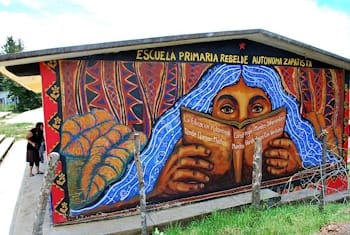
Contemporary Maya people are also responsible for many works of art which show them extending the traditional forms of their ancestors. Describing these trends, Miller and O'Neill state that "in addition to...continuing traditions, Maya art also encompasses new products made in new contexts, with artists and artisans continuing to reshape their identities in the face of changing politics and demographics. For instance, Maya art is made today for tourists - whether the wooden sculptures that numerous vendors sell to tourists at the archaeological site of Chichen Itza, the painted genre scenes made and sold in Santiago Atitlan and other towns around Lake Atitlan, or textiles produced and sold in tourist centers throughout Mexico and Guatemala."
In spite of this use for tourist markets, however, Miller and O'Neill add that "Maya art today can also be an art of resistance." They find examples in "the many murals, t-shirts, and figurines made in support of the Zapatista movement in Chiapas, starting in 1990s." In these pieces, "art was used both to raise awareness and to raise funds for autonomous governments or individuals." One example of an artist from a Maya-descended community using her art to record and protect her cultural traditions is Maruch Santíz Gómez, who lives in rural Chiapas and uses photography, written documentation, and other formats to record the wisdom of elders in her Tsotsil community.
Legacies of the Indigenous Art of South America
The impact of early Indigenous South American art is vast. According to Rebecca Stone, "the varied cultures of the South American Andes created some of the most transcendent art the world has ever known. In a formidable and demanding environment, the ancient peoples not only survived and prospered, but spent precious time and energy on aesthetic endeavors, from elaborate rituals to vast cities, from delicate gold work to sumptuous textiles."
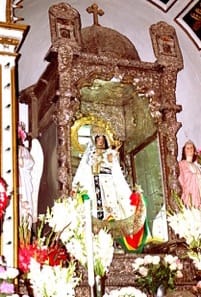
When the Spanish settled in Peru in the sixteenth century, they did much to eliminate Inca civilization. The few Indigenous artists able to continue practicing their craft were those willing to convert to Christianity and make artworks on suitable themes. One such example was the artist Francisco Tito Yupanqui. An Inca inhabitant of the town of Copacabana during the 1580s, Yupanqui, like many others, had converted to the colonisers' faith. He was selected to create an image of the Virgin Mary to bring protection and blessings to their town.
The piece Yupanqui created was said to have healing powers. According to Luisa Elena Alcalá, while the artist was creating the piece he had "bewildering encounters with the supernatural." He later reported that "strange things were happening to his image" whilst it was being sculpted. "Some days it seemed fine and finished, and then it would somehow become ruined again, only to fix itself." On the day the work was installed, February 2, 1583, "a miracle occurred when a candelabra fell on the head of the Corregidor [a government official] and he was unharmed, a promise of the future gifts that the Virgin would bestow upon Copacabana."
With the exception of works created in line with European interests, Inca art was generally destroyed by the settlers, part of a process of violent, attempted assimilation into Christian society. Still, thankfully, some Indigenous artistic traditions survived, and can be seen in contemporary art being made today. According to Mark Cartwright, "the European invaders...not only ruthlessly melted down or spirited away any precious Inca goods they found but also attempted to repress elements of Inca art....Distinctive Inca textile designs such as those connected to royal power were also discouraged but, in defiance, many of the indigenous peoples continued with their artistic traditions. Thanks to this perseverance and continuity, and despite an evolution where designs were blended with elements of colonial art, many traditional Inca designs and motifs survive to this day and are celebrated as such in the ceramics, metalwork, and textiles of modern Peru."
Another example of the survival of Inca art, according to Stone, can be found in contemporary Andean dress. "[T]oday the indigenous Andean peoples dress in a fascinating combination of Inca, Colonial Spanish, and modern clothing, embodying a true palimpsest of culture." The Inkakunaq Ruwaynin initiative, founded in 2014, is a collective of Peruvian women of Inca descent who make textiles woven using ancient techniques. While the proceeds of the work benefit the community, the textiles also serve to keep Inca artmaking form alive.
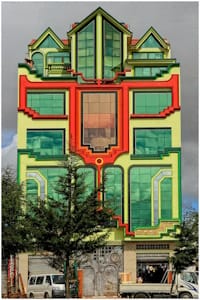
Contemporary architecture of South America also records the areas' native traditions. The town of El Alto in the Altiplano Highlands of Bolivia is associated with the Neo-Andean architecture of Freddy Mamani and others. This style is associated with bright colors and bold, often ziggurat like shapes and lines. It has roots in the Tiwanaku and Aymara cultures of the region.
Useful Resources on Indigenous Art of the Americas
- Art of the Andes: From Chavín to IncaOur PickBy Rebecca R. Stone
- Maya Art and ArchitectureOur PickBy Mary Ellen Miller and Megan E. O'Neill
- Native Arts of North America, Africa, and the South Pacific: An IntroductionBy George A. Corbin
- Native North American ArtOur PickBy Janet C. Berlo and Ruth B. Phillips
- North American Indian ArtOur PickBy David W. Penney
- The Art of Mesoamerica: From Olmec to AztecOur PickBy Mary Ellen Miller
- The Arts of South America: 1492-1850Our PickEdited by Donna Pierce
 Ask The Art Story AI
Ask The Art Story AI